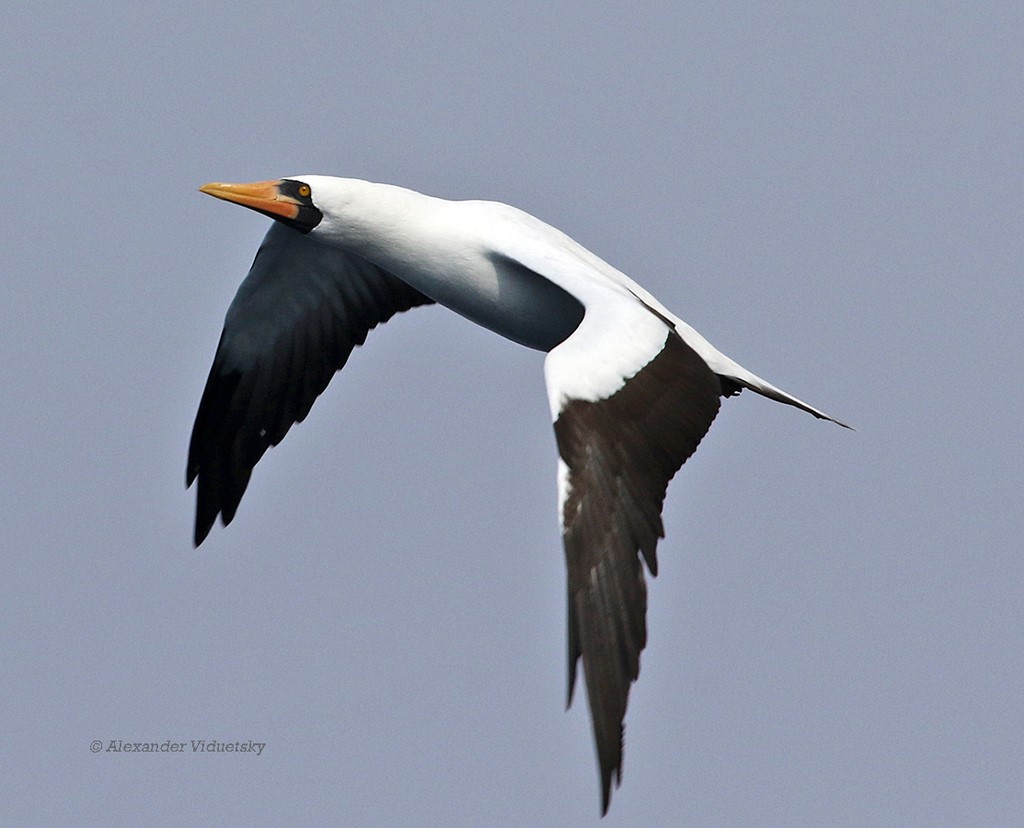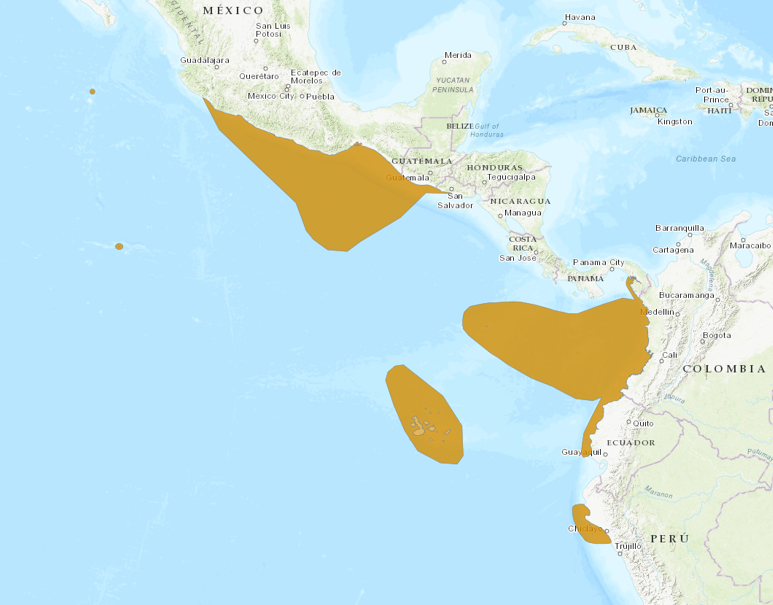Birdfinding.info ⇒ Common and conspicuous year-round in the Galápagos, especially around the colonies on Genovesa, Española, and Floreana, as well as Punta Pitt on Isla San Cristóbal. Also locally common around a few other nesting islands: Malpelo in Colombia and de la Plata in Ecuador. Elsewhere mostly unpredictable and sporadic, but generally present at low densities in offshore and near-coastal waters from Baja California to northwestern Peru. Small numbers appear most years in southern California waters; irregular farther north and in Hawaii.
Nazca Booby
Sula granti
Tropical eastern Pacific Ocean. Largely pelagic and rarely seen from land except on its breeding grounds.
Breeding. Most of the global population nests in the Galápagos on Genovesa, Española, and Floreana. Nesting in the two larger colonies is asynchronous: the Genovesa birds lay their eggs in August and those on Española in November.
Also nests in small numbers on offshore islets from Mexico to Peru: Revillagigedo, Clipperton Islands, Malpelo (Colombia), Isla de la Plata (Ecuador), Lobos de Tierra, and Lobos de Afuera.
Nonbreeding. Disperses across most of the tropical eastern Pacific Ocean from waters of Baja California to northwestern Peru. Stragglers regularly wander north as far as central California and west to Hawaii and Kiribati—where there are several recent records despite low coverage by observers.
More exceptional vagrants have been recorded north to Alaska (east of Amatuli Island; August 30, 2017), south to central Chile (Quintero; December 19, 2020), and once in the Caribbean Sea (offshore from Riohacha, Colombia; January 31, 2020).
Identification
Extremely similar to the more widespread and familiar Masked Booby—formerly regarded as conspecific. Adults of both are large, white overall with blackish-blue facial skin, mostly black flight feathers and tail, pale bill, and dull-colored feet.
Nazca’s bill is typically some shade of orange (but varies from pale-yellow to coral-pink) whereas Masked’s is typically yellowish or horn-colored.
The upperside of the tail differs from Masked in having mostly white central feathers (these are mostly black on Masked).
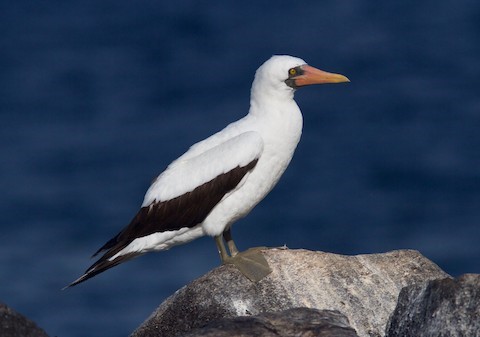
Nazca Booby, showing dull-olive feet. (Isla Española, Galápagos, Ecuador; June 16, 2017.) © Ken Havard
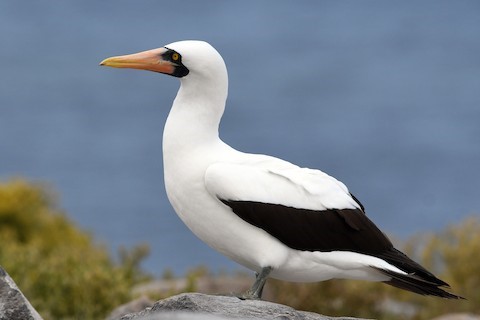
Nazca Booby. (Punta Suarez, Isla Española, Galápagos, Ecuador; November 25, 2019.) © David M. Bell
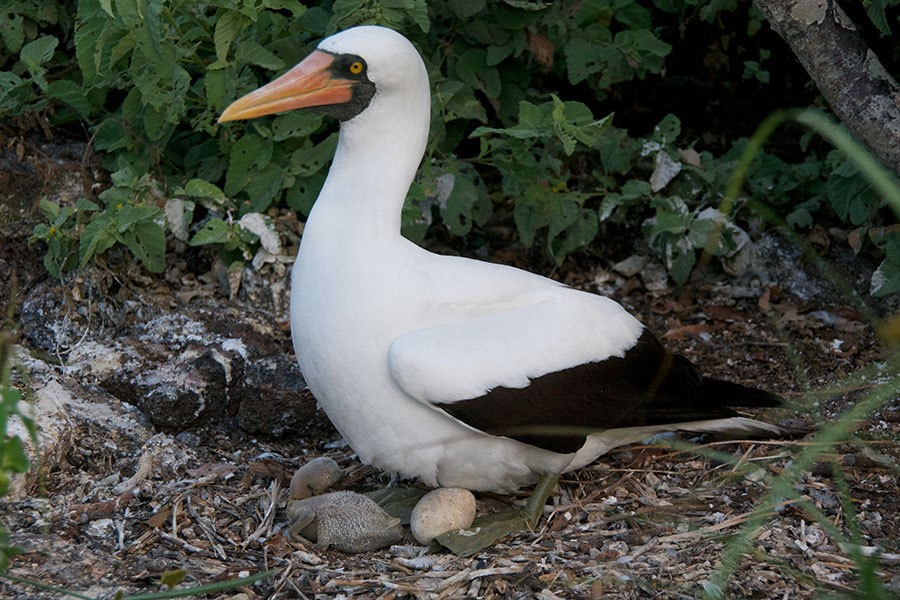
Nazca Booby, with newly hatched chick and unhatched egg. (Prince Philip’s Steps, Isla Genovesa, Galápagos, Ecuador; May 1, 2012.) © John Sullivan
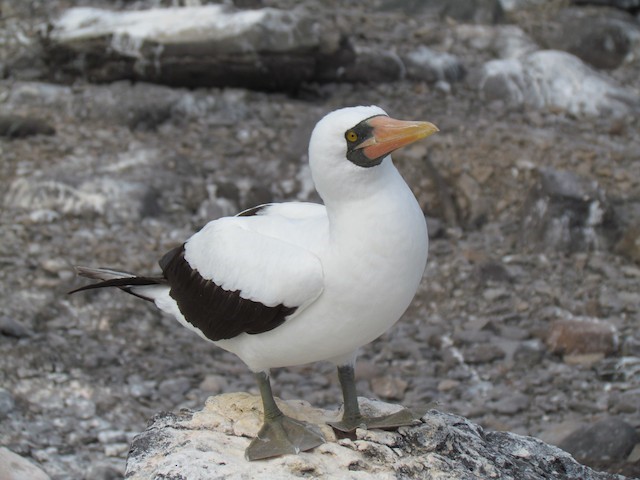
Nazca Booby, showing dull-olive feet. (Punta Suarez, Isla Española, Galápagos, Ecuador; March 27, 2012.) © Lisa Owens

Nazca Booby. (Isla Española, Galápagos, Ecuador; August 18, 2010.) © Seigmond

Nazca Booby with flushed pinkish-orange bill. (Isla Española, Galápagos, Ecuador; September 15, 2012.) © Gerald Friesen

Nazca Booby with pale, plain bill. (Punta Suarez, Isla Española, Galápagos, Ecuador; January 18, 2017.) © Richard Greenhalgh
Often follows ships at sea and habitually rests on flotsam and buoys. Both of these tendencies seem to be stronger in Nazca than in Masked.
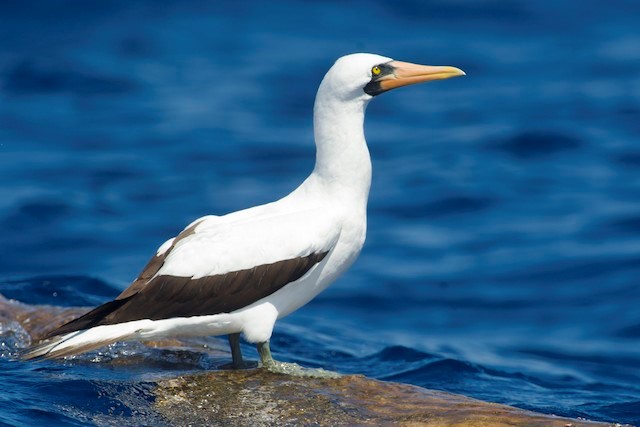
Nazca Booby, resting on flotsam at sea. (Offshore from Santa Rosa, Guatemala; December 31, 2015.) © John Cahill
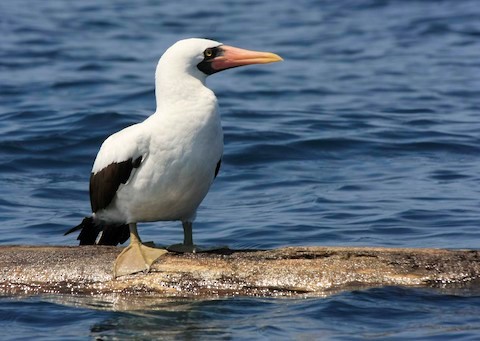
Nazca Booby, resting on flotsam at sea. (Offshore from Tumaco, Colombia; February 28, 2010.) © David Beadle

Nazca Booby. (Prince Philip’s Steps, Isla Genovesa, Galápagos, Ecuador; June 7, 2018.) © Glenn Lahde

Nazca Booby. (Punta Suarez, Isla Española, Galápagos, Ecuador; November 25, 2019.) © David M. Bell

Nazca Booby, showing grayish-olive feet. (Punta Suarez, Isla Española, Galápagos, Ecuador; March 27, 2012.) © Lisa Owens

Nazca Booby. (Punta Suarez, Isla Española, Galápagos, Ecuador; November 25, 2019.) © David M. Bell

Nazca Booby. (Darwin Bay, Isla Genovesa, Galápagos, Ecuador; May 19, 2006.) © Marvin Hyett
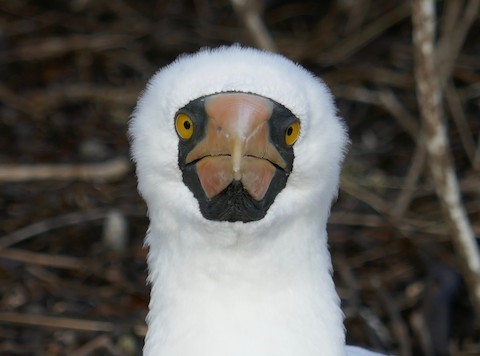
Nazca Booby. (Isla San Cristóbal, Galápagos, Ecuador; January 23, 2017.) © Greg Vassilopoulos

Nazca Booby. (Punta Suarez, Isla Española, Galápagos, Ecuador; November 25, 2019.) © David M. Bell

Nazca Booby. (Prince Philip’s Steps, Isla Genovesa, Galápagos, Ecuador; December 10, 2017.) © David Bree

Nazca Booby. (Punta Suarez, Isla Española, Galápagos, Ecuador; January 18, 2017.) © Richard Greenhalgh

Nazca Booby. (Prince Philip’s Steps, Isla Genovesa, Galápagos, Ecuador; May 21, 2014.) © Shawn Billerman
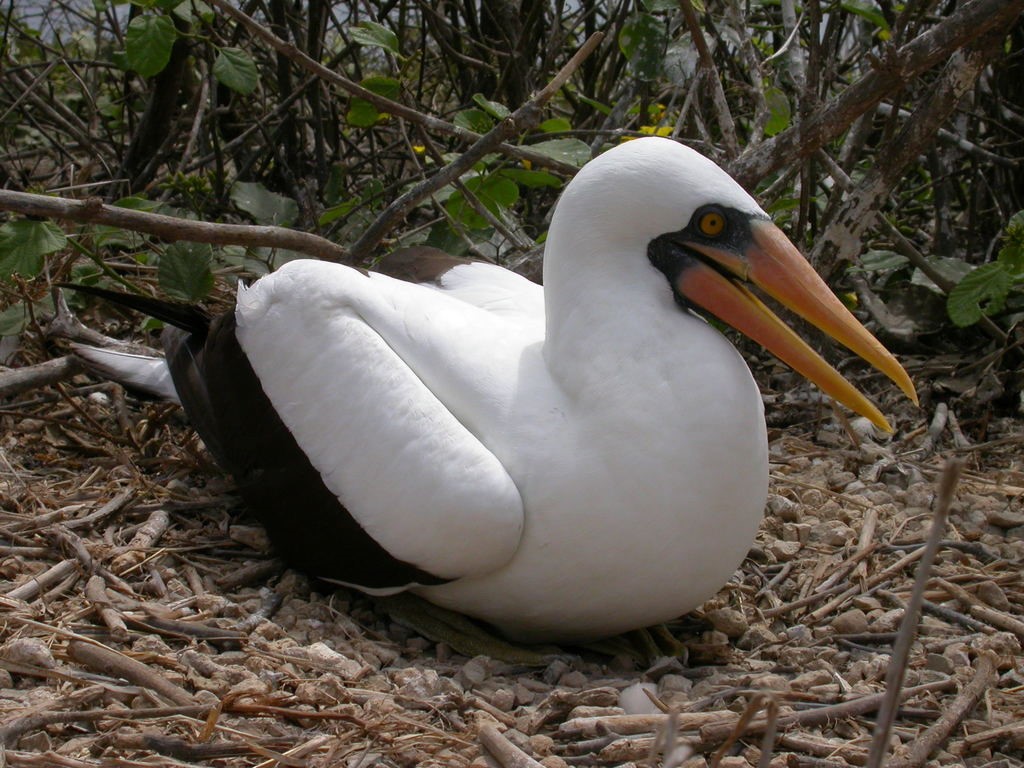
Nazca Booby at nest. (Isla de la Plata, Ecuador; October 14, 2006.) © Pete Corradino

Nazca Booby, pair engaged in mutual preening. (Isla Genovesa, Galápagos, Ecuador; July 22, 2018.) © Reinier Munguia
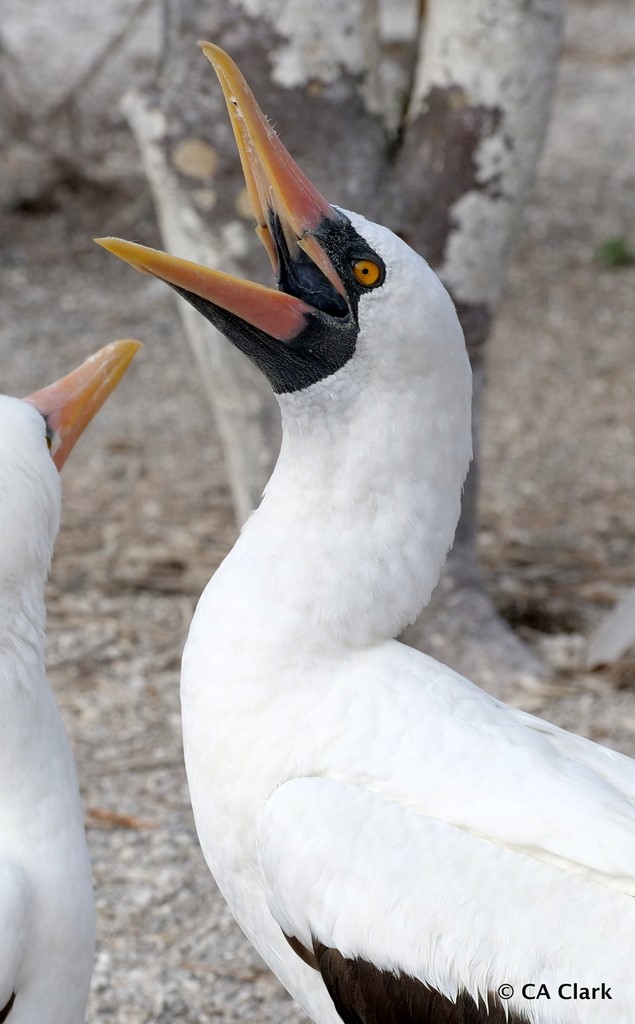
Nazca Booby. (Isla Genovesa, Galápagos, Ecuador; July 22, 2019.) © C.A. Clark
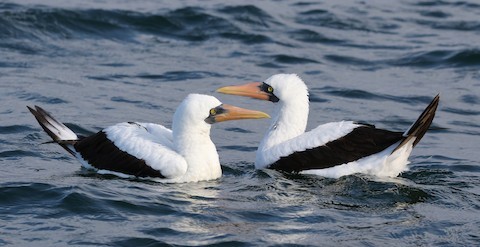
Nazca Booby—the bird on the left shows typically white central feathers on uppertail. (San Diego Bay, California; December 16, 2017.) © Tom Benson

Nazca Booby, showing mostly black central tail feathers—i.e., more like Masked than typical Nazca. (San Diego Bay, California; December 19, 2017.) © Alex Abela

Nazca Booby. (South of San Clemente Island, California; September 6, 2018.) © David Pereksta
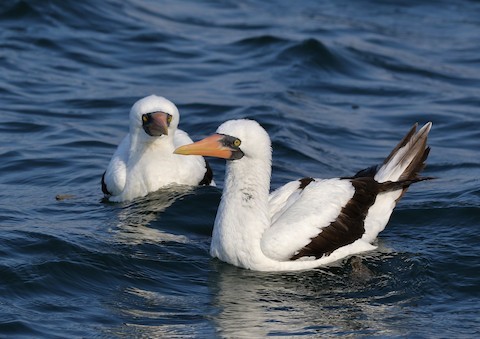
Nazca Booby, showing mostly white central feathers on uppertail. (San Diego Bay, California; December 16, 2017.) © Tom Benson
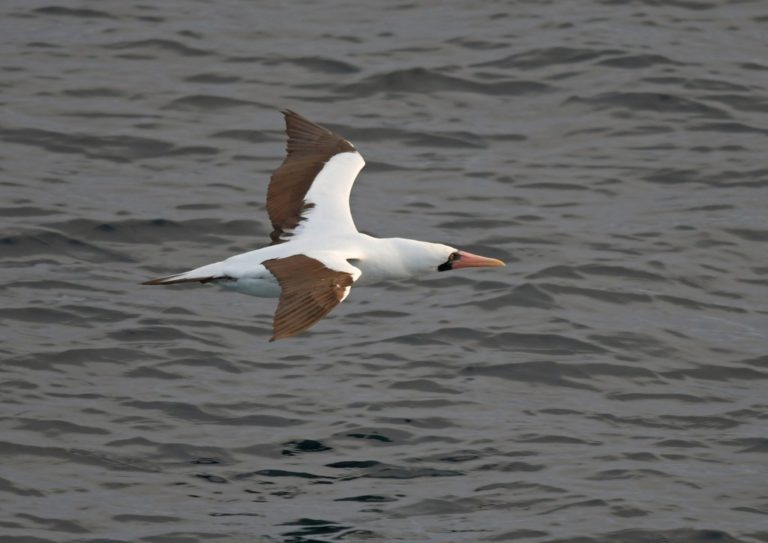
Nazca Booby in flight, dorsal view showing mostly white central feathers on uppertail. (Isla Santa Fe, Galápagos, Ecuador; November 3, 2018.) © Joshua D. Vandermeulen

Nazca Booby in flight, dorsal view showing mostly white central feathers on uppertail. (Isla Genovesa, Galápagos, Ecuador; August 9, 2010.) © John Crosby
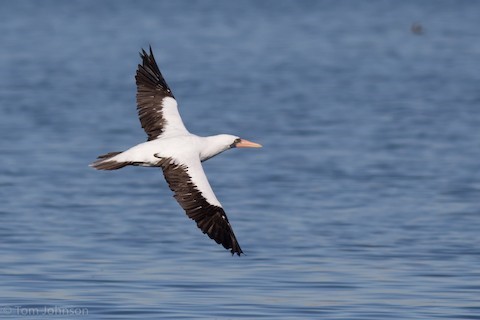
Nazca Booby in flight, dorsal view showing mostly white central feathers on uppertail. (San Diego Bay, California; December 12, 2017.) © Tom Johnson
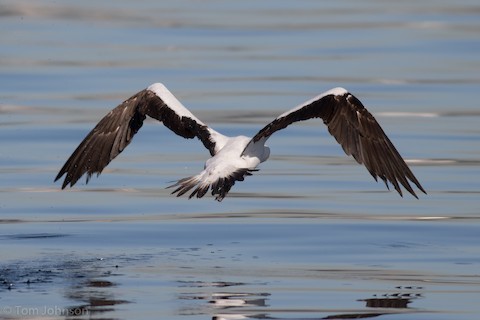
Nazca Booby in flight, dorsal view showing mostly white central feathers on uppertail. (San Diego Bay, California; December 12, 2017.) © Tom Johnson
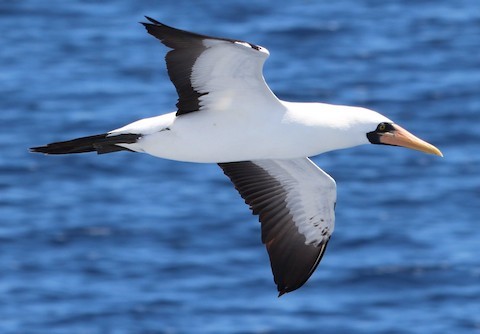
Nazca Booby. (East of Isla Santiago, Galápagos, Ecuador; January 27, 2017.) © Burke Korol
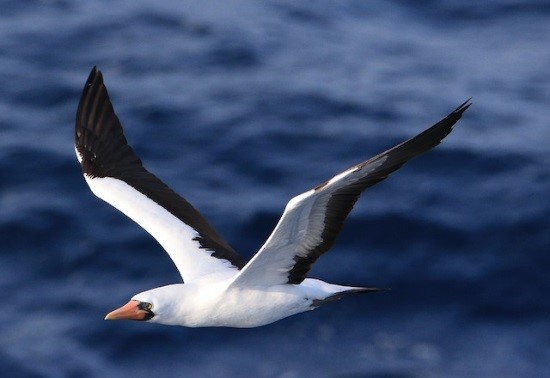
Nazca Booby. (Offshore from Tapachula, Chiapas, Mexico; October 30, 2015.) © Moe Bertrand
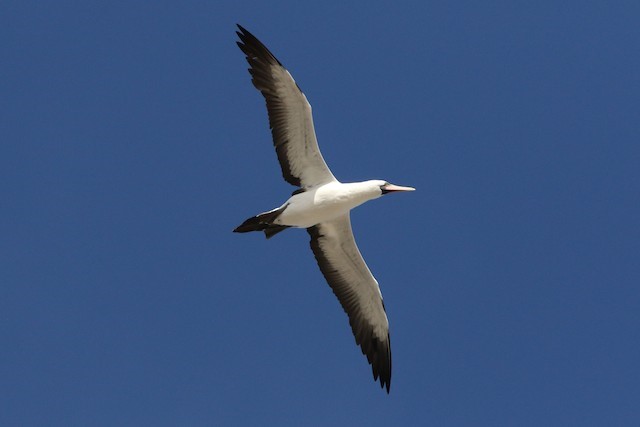
Nazca Booby in flight, ventral view. (Prince Philip’s Steps, Isla Genovesa, Galápagos, Ecuador; December 18, 2017.) © Olivier Langrand

Nazca Booby in flight, ventral view. (Offshore east of Kiribati; February 13, 2020.) © Noam Markus
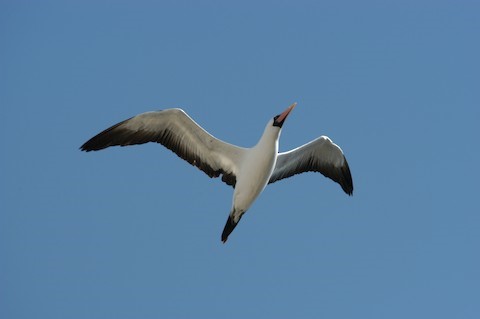
Nazca Booby in flight, ventral view. (Darwin Bay, Isla Genovesa, Galápagos, Ecuador; May 19, 2006.) © Marvin Hyett
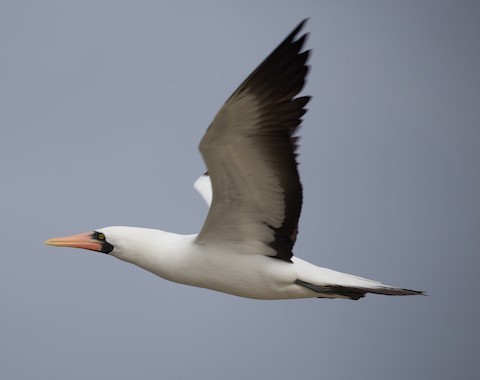
Nazca Booby in flight, ventral view. (Prince Philip’s Steps, Isla Genovesa, Galápagos, Ecuador; July 15, 2015.) © Meg Barron

Nazca Booby in flight, ventral view. (Punta Suarez, Isla Española, Galápagos, Ecuador; November 25, 2019.) © David M. Bell

Nazca Booby in flight, ventral view. (Offshore from Tapachula, Chiapas, Mexico; October 30, 2015.) © Moe Bertrand
Immature Plumages. Juveniles have brown upperparts and a brown hood—much like a typical adult Brown Booby, but Nazca’s hood is not as crisply defined. As they age, the areas of brown coloration are replaced by white.
The bill begins as dark yellowish-brown, then becomes paler, then eventually turns toward orange.
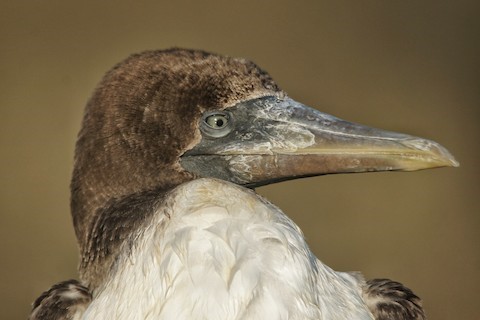
Nazca Booby, juvenile. (Cedros, Puntarenas, Costa Rica; February 22, 2017.) © Jorge Zuñiga Lopez

Nazca Booby, juvenile. (Punta Suarez, Isla Española, Galápagos, Ecuador; April 28, 2018.) © Paul Bartlett
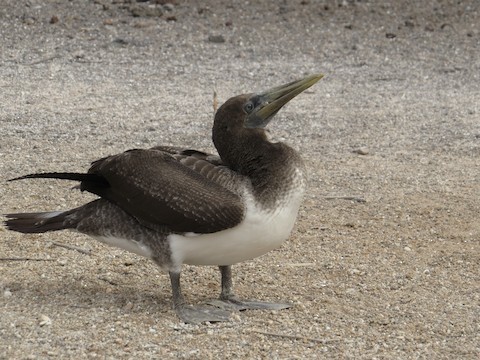
Nazca Booby, juvenile. (Prince Philip’s Steps, Isla Genovesa, Galápagos, Ecuador; May 25, 2018.) © Ann Truesdale

Nazca Booby, juvenile. (Isla Genovesa, Galápagos, Ecuador; June 10, 2019.) © Teri

Nazca Booby, juvenile. (Isla Española, Galápagos, Ecuador; May 18, 2006.) © Marvin Hyett

Nazca Booby, juvenile. (Punta Suarez, Isla Española, Galápagos, Ecuador; February 18, 2010.) © Victor W. Fazio III
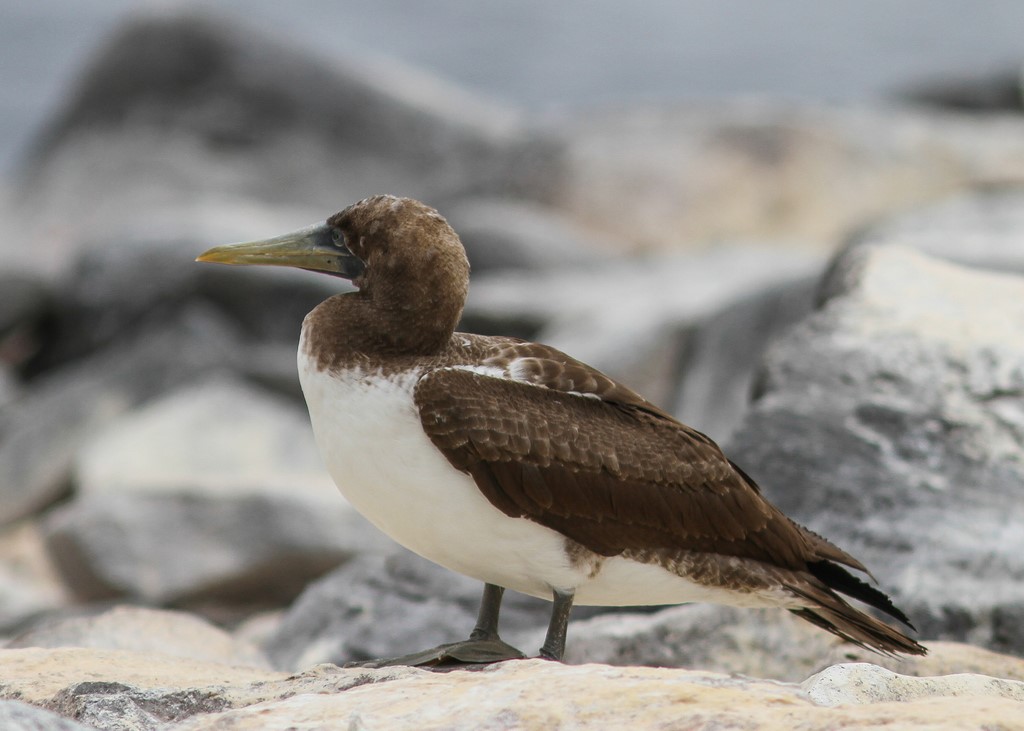
Nazca Booby, juvenile. (Isla Española, Galápagos, Ecuador; July 5, 2017.) © dkirschke

Nazca Booby, juvenile. (Cedros, Puntarenas, Costa Rica; February 22, 2017.) © Jorge Zuñiga Lopez
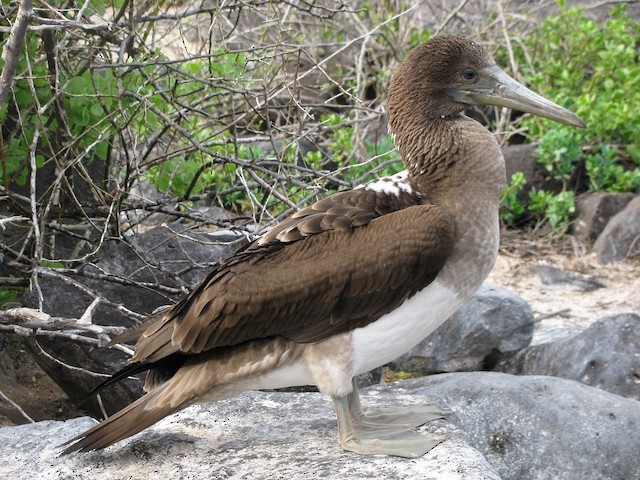
Nazca Booby, juvenile, with brown hood that extends down onto the breast. (Punta Suarez, Isla Española, Galápagos, Ecuador; January 16, 2010.) © Derek Hudgins

Nazca Booby, juvenile. (Isla Santa Cruz, Galápagos, Ecuador; April 24, 2018.) © hsaenzjr1

Nazca Booby, juvenile. (Isla Española, Galápagos, Ecuador; May 18, 2006.) © Marvin Hyett
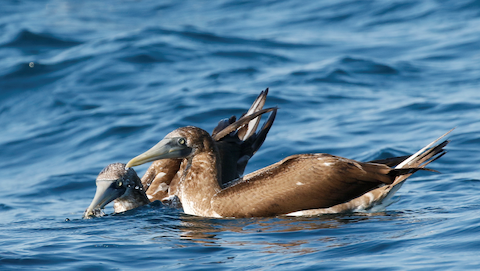
Nazca Booby, juveniles. (Offshore from Santa Cruz Huatulco, Oaxaca, Mexico; November 6, 2017.) © Stephen Knox

Nazca Booby, immature. (Offshore from Los Barriles, Baja California Sur, Mexico; August 20, 2013.) © Steven Mlodinow

Nazca Booby, immature. (“The Ridge,” Baja California Sur, Mexico; August 21, 2016.) © Robert McNab
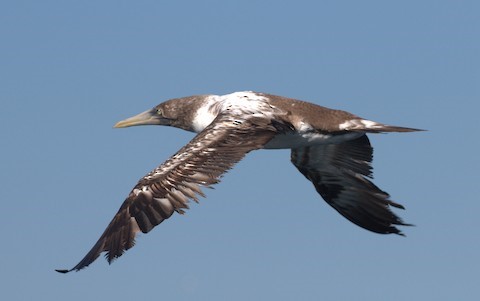
Nazca Booby, immature. (Northeast of Anacapa Archipelago, California; August 28, 2020.) © Joel Barrett
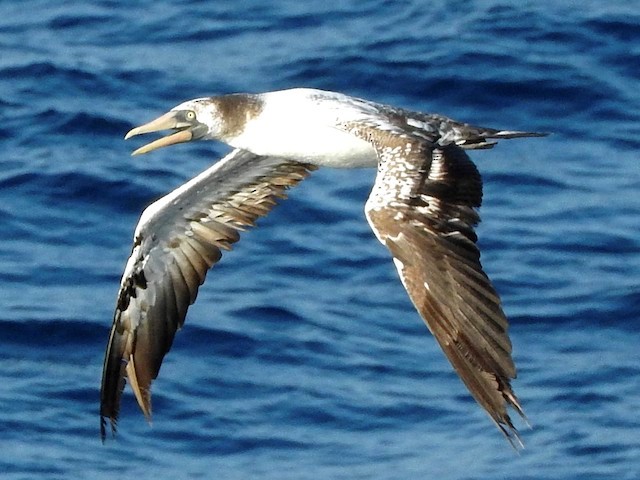
Nazca Booby, immature. (Offshore from Retalhuleu, Guatemala; December 15, 2017.) © Noam Markus

Nazca Booby, immature. (Offshore from San Diego, California; September 23, 2018.) © Nicole Desnoyers
In all immature plumages, Masked and Nazca Boobies have more extensively white underwings than other boobies of the same age class.
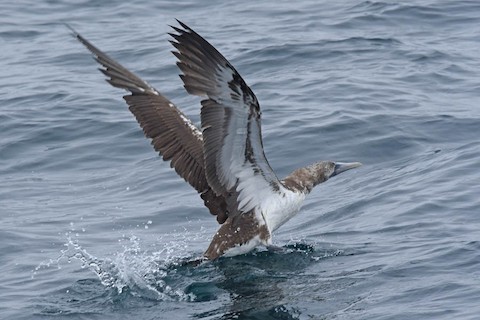
Nazca Booby, immature. (Offshore from Half Moon Bay, California; October 10, 2020.) © Troy Hibbitts

Nazca Booby, immature. (Offshore from San Diego, California; September 23, 2018.) © Nicole Desnoyers
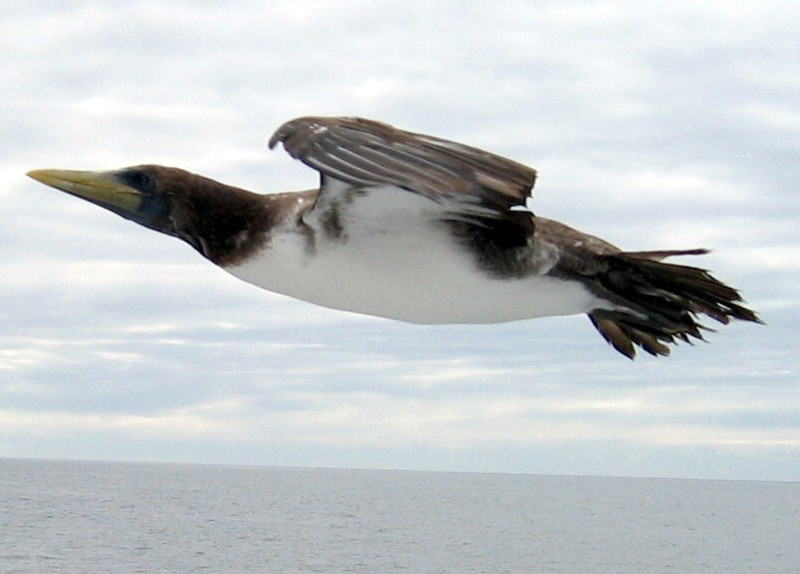
Nazca Booby, juvenile. (East of Isla Santiago, Galápagos, Ecuador; June 19, 2006.) © Geir Drange
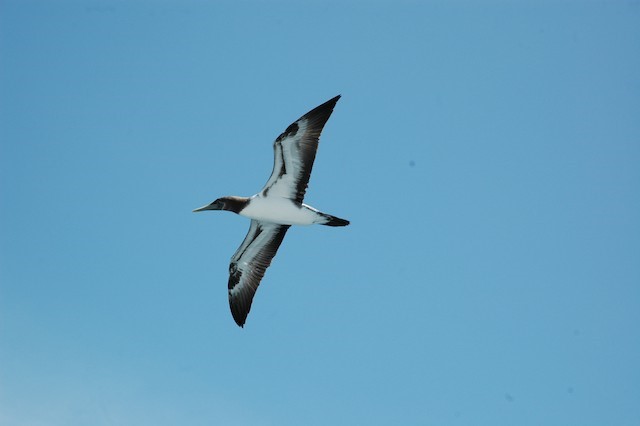
Nazca Booby, juvenile. (Charles Darwin Research Station, Isla Santa Cruz, Galápagos, Ecuador; April 3, 2016.) © Andrew Dobson
Subadult Plumages. During their second and third years, subadults become whiter. Compared to Masked, subadult Nazca tends to retain a dark shadow on the crown and nape.

Nazca Booby, subadult. (Puerto Arista, Chiapas, Mexico; October 21, 2015.) © Rafael Paredes Montesinos
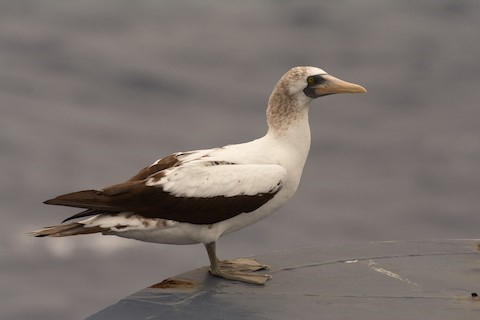
Nazca Booby, subadult perched on ship. (Offshore from Ensenada, Baja California, Mexico; July 20, 2019.) © Charlie Wright

Nazca Booby, subadult. (Offshore from Santa Cruz Huatulco, Oaxaca, Mexico; November 6, 2017.) © Stephen Knox
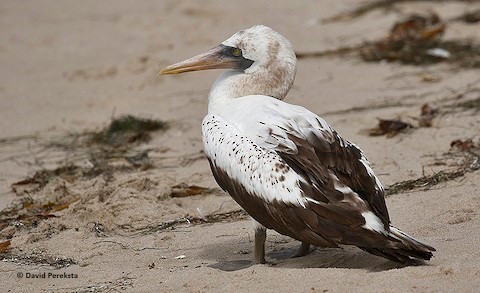
Nazca Booby, subadult. (County Line Beach, Malibu, California; August 6, 2018.) © David Pereksta

Nazca Booby, subadult. (County Line Beach, Malibu, California; August 6, 2018.) © David Pereksta
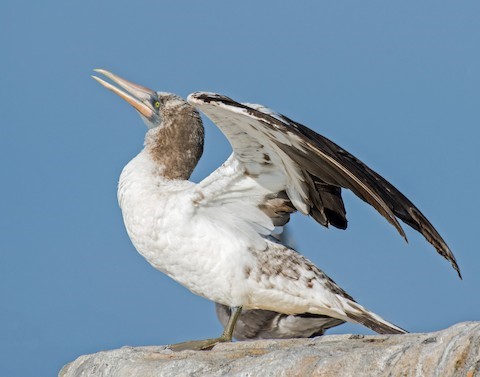
Nazca Booby, subadult. (Dana Point, California; July 26, 2019.) © Alison Davies

Nazca Booby, subadult. (Imperial Beach Pier, San Diego, California; October 10, 2020.) © Andrew Newmark
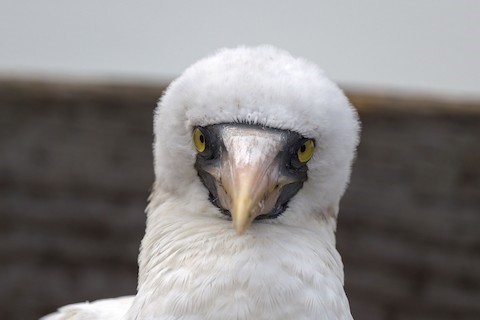
Nazca Booby, subadult. (Imperial Beach Pier, San Diego, California; October 10, 2020.) © Andrew Newmark

Nazca Booby, subadult. (East of Santa Barbara Island, California; October 6, 2018.) © Naresh Satyan

Nazca Booby, subadult. (East of Santa Barbara Island, California; October 6, 2018.) © David Pereksta

Nazca Booby, subadult. (Southeast Farallon Island, California; July 25, 2020.) © Alvaro Jaramillo

Nazca Booby, subadult. (Offshore from Riohacha, La Guajira, Colombia; January 31, 2020.) © Beny Wilson
Cf. Masked Booby. In the eastern Pacific, where they occur together locally, Nazca Booby is nearly identical to Masked. At close range, adult Nazca can be distinguished by its rosy or orange bill and sometimes by more extensive white on its tail—mainly the central feathers on the upperside.
Juvenile Nazca sometimes differs from juvenile Masked in having a paler and larger brownish hood that extends well down onto the breast—but this varies and many juvenile Nazcas have the same pattern as juvenile Masked.
Immature and subadult Nazca’s typical plumage progression differs from Masked’s: Most immature Nazcas do not develop a distinct white collar; instead, the throat turns white first, leaving a dark cape (variable, but typically a shadow that is darkest on the crown and nape).
Cf. Red-footed Booby. White morph Red-footed Boobies of the eastern Pacific have all-dark tails and appear similar to Nazca at a distance. Nazca’s tail is darker over a small portion whereas Red-footed (of this particular morph) has a tail that is extensively gray. Nazca’s extensive blackish-blue mask is diagnostic, although Red-footed Boobies also show a narrowly dark mask.
The wing patterns differ more definitively: white morph Red-footed has more extensive white on the upperwing, and on the underwing it has an isolated black “comma” on the primary linings just beyond the wrist.
Cf. Blue-footed Booby. Young Nazca Boobies resemble young Blue-footed Boobies at multiple stages—mainly as juveniles and subadults, less so during the intervening stages. Juvenile Blue-footed has a more extensive brown hood (often like adult Brown Booby, but paler). Subadult Blue-footed often appears to have a mask (dark feathers, not skin) but can be distinguished from subadult Nazca by its all-dark upperwing (i.e., lacking the white leading edge that subadult Nazca develops). The underwing pattern of Blue-footed is similar to that of juvenile and immature Nazca, but the white areas on Blue-footed’s underwings are narrower and shorter, extending only slightly past the wrist.
Cf. Brown Booby. Juvenile Nazca has approximately the same color pattern as an adult Brown Booby—i.e., brown upperparts and a brown hood—but its hood is much less extensive (ending above the breast), less sharply defined, and usually has a white notch in the center. Underwing patterns also differ.
Cf. Peruvian Booby. Like the adult Nazca, Peruvian Booby has dark mask that contrasts with its white head and neck. Peruvian is distinguishable at all stages by its all-dark upperwings and back, and its complex underwing pattern.
Notes
Monotypic species. Traditionally considered a subspecies of Masked Booby (S. dactylatra) but formally recognized as separate since 2000, based in part on evidence that the two forms breed in colonies together without substantial interbreeding.
References
Alderfer, J., and J.L. Dunn. 2014. National Geographic Complete Birds of North America (Second Edition). National Geographic Society, Washington, D.C.
BirdLife International. 2018. Sula granti. The IUCN Red List of Threatened Species 2018: e.T22728990A132659882. https://dx.doi.org/10.2305/IUCN.UK.2018-2.RLTS.T22728990A132659882.en. (Accessed March 1, 2021.)
eBird. 2021. eBird: An online database of bird distribution and abundance. Cornell Lab of Ornithology, Ithaca, N.Y. http://www.ebird.org. (Accessed March 1, 2021.)
Fagan, J., and O. Komar. 2016. Peterson Field Guide to the Birds of Northern Central America. Houghton Mifflin Harcourt, New York.
Garrigues, R., and R. Dean. 2014. The Birds of Costa Rica: A Field Guide (Second Edition). Cornell University Press.
Harrison, P. 1983. Seabirds: An Identification Guide. Houghton Mifflin, Boston.
Howell, S.N.G., I. Lewington, and W. Russell. 2014. Rare Birds of North America. Princeton University Press.
Howell, S.N.G., and S. Webb. 1995. A Guide to the Birds of Mexico and Northern Central America. Oxford University Press.
Howell, S.N.G., and K. Zufelt. 2019. Oceanic Birds of the World. Princeton University Press.
McMullan, M., and T. Donegan. 2014, Field Guide to the Birds of Colombia (Second Edition). Fundación Proaves de Colombia, Bogotá.
Pitman, R.L., and J.R. Jehl. 1998. Geographic variation and reassessment of species limits in the “Masked” Boobies of the eastern Pacific Ocean. Wilson Bulletin 110:155-170.
Pyle, R.L., and P. Pyle. 2017. The Birds of the Hawaiian Islands: Occurrence, History, Distribution, and Status. Version 2 (January 1, 2017). http://hbs.bishopmuseum.org/birds/rlp-monograph/. B.P. Bishop Museum, Honolulu, Hawaii.
Ridgely, R.S., and P.J. Greenfield. 2001. The Birds of Ecuador, Volume II: Field Guide. Cornell University Press.
Ridgely, R.S., and J.A. Gwynne. 1989. A Guide to the Birds of Panama (Second Edition). Princeton University Press.
Schulenberg, T.S., D.F. Stotz, D.F. Lane, J.P. O’Neill, and T.A. Parker. 2007. Birds of Peru. Princeton University Press.
Xeno-Canto. 2021. Nazca Booby – Sula granti. https://www.xeno-canto.org/species/Sula-granti. (Accessed March 1, 2021.)
